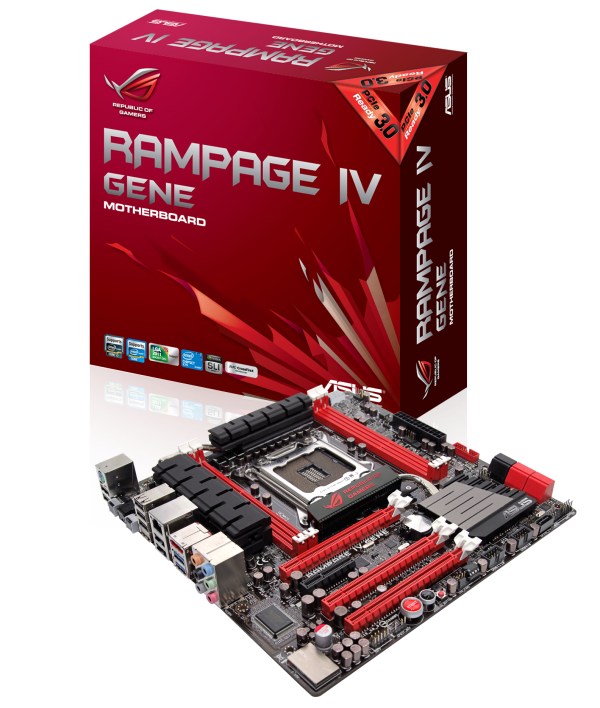ASUS Republic of Gamers and X79 ROG Review – Rampage IV Gene, Formula and Extreme
by Ian Cutress on August 3, 2012 1:00 PM EST- Posted in
- Motherboards
- Asus
- X79
- ROG
If a user wants the top end of performance, they are going to have to look towards the X79 and Sandy Bridge-E platform. If they want the best of that platform, it would not hurt to start looking at the Republic of Gamers range to see if a motherboard would suit them. In this review, we have analyzed the Rampage IV Gene, the Rampage IV Formula and the Rampage IV Extreme - the entire ASUS Republic of Gamers range for this platform, with a mélange of real-world tests and some more exotic extreme enthusiast scenarios.
The Republic of Gamers motherboards for X79 do not come in cheap. For a platform where the processor range varies from $300 to $1000, cost is rarely a talking point. However, for completeness, here is how the ROG boards currently stack up price wise (from Newegg) against the rest of the X79 range (some of which we at AnandTech have tested):
$445 - EVGA X79 Classified
$430 - ASUS Rampage IV Extreme
$390 - MSI Big Bang-XPower II
$370 - ASRock X79 Champion
$360 - ASUS Rampage IV Formula
$350 - Gigabyte G1. Assassin2
$345 - ASRock X79 Extreme9
$310 - ASUS P9X79 Pro
$310 - ECS X79R-AX Black Extreme
$300 - EVGA X79 SLI
$280 - ASUS Rampage IV Gene
$265 - Intel DX79SI
$260 - ASUS P9X79
$245 - ASRock X79 Extreme7
$240 - Gigabyte X79-UD3
$230 - Biostar TPower X79
$225 - ASRock X79 Extreme4
$214 - ASRock X79 Extreme4-M
With the Formula and Extreme both catering for the more-than-dual GPU crowd, it is unsurprising that they are more at the upper end of the price range. The Rampage IV Gene is the most expensive of the MicroATX boards, but it does put some of the full sized ATX boards above it to shame in terms of performance.
ASUS Rampage IV Gene Conclusion
High end, small(er) form factor motherboards can often be a bit of a quandary. On the one hand, a user could have a serious processor costing around $1000 with all the bells and whistles a processor should have - why would they consider pairing it with a motherboard that limits itself on size? The answer lies in usage scenarios, and ultimately performance.
The Gene is not a normal mATX board - ASUS have asked me to state explicitly that the Gene is more of a entry level ROG motherboard rather than one aimed at SFF systems. It gets the benefit of ROG development, whilst retaining a modicum of mobility and the utmost of performance.
In my view, the Gene is a great product if a user has two PCIe devices or less. In terms of new hardware over other X79 products, the ROG glaze expands to the focused SupremeFX III audio and the Intel NIC, but the selling point of the Gene will be in the ASUS branded features. ROG Connect for example will let a user manage a PC from a mobile device; the fan headers on board are typical of ASUS and better than any other manufacturers' implementation. USB BIOS Flashback helps users updating the BIOS without CPU, Memory or a VGA, and the heatsinks are buffed up to take the strain of an enthusiast system.
The main competition from the Gene comes from the boards priced around it - the Intel DX79SI for example is a full sized ATX board with dual Intel NICs or the ASUS P9X79 has a full complement of memory slots. Compared to the other mATX boards, such the cheap-as-chips ASRock X79 Extreme4-M, the Gene is similar in terms of outward facing hardware, but surpasses the 4-M for performance and feature set. This is not forgetting the Gene also come with 3-years warranty and ASUS Premium Service for North American customers.
The Gene is not to be taken lightly. Despite the extra cost over the Extreme4-M, the Gene still gets big thumbs up from the ASUS ROG garnish and performance thanks to ASUS MultiCore Enhancement. Overclocking was great too, matching the other ROG boards easily enough and beating many of the other X79 competitors for performance and ease-of-use.
The Gene is still missing a delicate spark. The extras in the box were perhaps missing a little bonus, such as a USB 3.0 panel. If I were in the design team, I would consider reshuffling the IO panel to rid the empty space, and consider stripping out the audio and placing it on an add-in card, then have the PCIe as x1, x16, x8, x16. There would perhaps be space for a built-in WiFi card (or include it in the audio card).
Nevertheless, the Gene is still a great product for an enthusiast. As a result, I would like to give the Rampage IV Gene an AnandTech Editors' Choice Bronze Award.

ASUS Rampage IV Gene
Bronze Award











34 Comments
View All Comments
Flunk - Friday, August 3, 2012 - link
Ivy Bridge is more of a notebook oriented update anyway. The much better integrated graphics don't really matter to us anyway.G-Man - Friday, August 3, 2012 - link
Fantastic article, Ian! You must have been working on this for a long time. Thanks for a great read.B - Friday, August 3, 2012 - link
Ian -I would like to point out that under that nice metal Creative X-FI chip badge is, in fact, a Realtek processor. The Soundblaster piece of this is a merely a software implementation. I have this motherboard and was quite disappointed to discover this.
Thanks for great and thorough article.
just4U - Friday, August 3, 2012 - link
Indeed.. It's a little bit of a letdown. It will be nice if they are pushed away from the realtek chip now that Gigabyte is into similiar type boards which utilize the Creative recon chips.primonatron - Friday, August 3, 2012 - link
The article should be edited to specificy that it's only a Relatek chip, not a Creative one, at this point it's just blatent false advertising.When doing the review, did Anandtech actually do a Windows 7 install on it themselves?
They would have known if they did.
IanCutress - Friday, August 3, 2012 - link
As per my comment above, it states this in the tenth page. And yes, I do install Windows 7 fresh on every board I test. It would be crazy not to. I see the whole install procedure at least twice a week, as well as installing each vendors drivers and software. The ASUS install procedure for drivers is all one-button automatic, no user input required, no giant screens flashing up on the screen to ask to confirm this that or the other.Ian
primonatron - Friday, August 3, 2012 - link
I would not put " ASUS have dug into their pockets to provide the Gene with a better-than-Realtek solution, in the SupremeFX III" since it IS a Realtek solution.IanCutress - Friday, August 3, 2012 - link
Written in page 10:"In our SupremeFX III, we essentially get a Realtek codec (presumed ALC898), but by being stage III this chip is isolated from the rest of the board, has a separate EMI shield around the chip, its own PCB layer for audio tracing, a 1500 mF capacitor to reduce ripple, and gold plated audio jacks to minimize resistance. As a result, the SNR is increased to 110dB."
Ian
just4U - Saturday, August 4, 2012 - link
It also needs to be noted that soundchips getting decent software can be a fairly substantial bump.. atleast from my point of view. I seem to recall Creative nailing a company to the wall because they used software the emulated soundblaster stuff and they were reall popular 7 years back.just4U - Friday, August 3, 2012 - link
I've been using these for several years... and have always found that they offer more then most standard ATX boards in lesser and similiar price ranges. Your not paying the Big bucks but you have your foot in the door.. (as it were.. lol)They can be problematic at times mind you.. I've found that quality control can be a bit of an issue with dead boards coming in now and again. We are dealing with sensitive electronics mind you so that happens.
I must say they do have some competition now with Gigabyte's M3s sniper boards, that do utilize a true recon3d sound chip from Creative (as opposed to a realtek chip with software emulation). My hope is that it pushes Asus towards a similiar move as the sound is a key feature for these baby boards.
Personally I think the Gene series deserves your silver award. While high end boards can be had from all makers getting a good solid feature rich gaming MATX board is not the norm and they are almost allways a pleasure to work with.
Great review Ian.